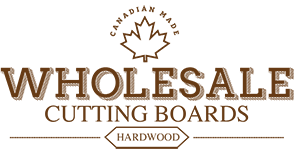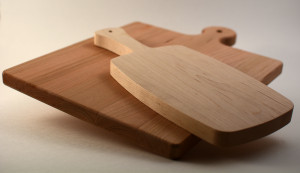Frequently Asked Questions About Cutting Boards
The material used in our cutting boards
Q. Are your cutting boards made in Canada?
A. All of our cutting boards are made right here in Canada, using the highest quality hardwoods. Read more about Cutting boards made in Canada.
Q. What wood species do you offer?
A. All of our boards are made from cherry, maple or walnut, hardwoods grown here in Canada. Read more about the best hardwood for cutting boards
Q. Is the wood you are using in your cutting boards Canadian?
A. Yes, each board is crafted from hardwoods grown in Canada.
Caring for cutting boards
Q. Can I put my cutting board in the dishwasher?
A. Wood products should never be put in the dishwasher. It causes them to unglue and to deteriorate. Use warm water with a mild detergent, rinse in clean water and air dry—that’s all you need to keep your boards in good shape for years. Read more about cutting boards in the dishwasher.
Q. Is the glue used safe?
A. All the glue used in our cutting boards is food grade and totally safe. Read more on glue safety in cutting boards .
Q. Can I put a wood cutting board in the oven?
A. No, you can’t put the cutting board in the oven. The glue will dry, and the hardwood will dry and split. Read more about why
Q. How do I clean my cutting board?
A. Rinse your board right after you use it. At that point or later use a cleaner with anti-bacterial properties for a deeper clean. Read more about cleaning your wooden cutting boards.
Q. How do I get rid of stains?
A. Both baking soda and coarse salt work well. Start with a dry cutting board and sprinkle it well with the baking soda or the salt. Use a wet brush or a sponge to scrub out the stain. You may need to repeat the process more than once to get out deep stains. See more on How to remove stains from your hardwood cutting board.
Q. What is the best way to prevent a cutting board from slipping on the counter-top?
A. Place a damp kitchen towel or a non-slip mat under the cutting board to prevent slipping during use.
Q. Can I use the same cutting board for meat and vegetables?
A. It’s recommended to have separate cutting boards for raw meat and vegetables to avoid cross-contamination. If using one board, wash it thoroughly between uses. Read more about using the same cutting board for meat and vegetables.
Q. Which material is best for a cutting board?
A. The best material depends on personal preference and intended use. Wooden boards are preferred by some for their aesthetics and knife-friendliness, while plastic boards are known for being durable and dishwasher-safe.
Q. Can glass cutting boards damage knives?
A. Yes, glass cutting boards can be harsh on knife edges, leading to faster dulling. It’s generally recommended to use softer materials like wood or plastic for knife longevity. Read more about Glass VS Hardwood Cutting boards.
Q. How do I know when it’s time to replace a cutting board?
A. Signs of wear, deep cuts, excessive warping, and unpleasant odors are indications that a cutting board may need replacement for safety and hygiene reasons. Read more about when is it time to replace your cutting boards.
Q. My cutting board smells. What can I do?
A. White vinegar works well. Put vinegar in a spray bottle and spritz your board when you notice odors. Vinegar not only neutralizes bad smells, it also helps to disinfect the board naturally. Read more about smelly cutting boards.
Q. Do I need to oil my cutting board?
A. Oiling your cutting board periodically, depending on its use, will add to its attractiveness and durability. Every cutting board will last for years, but using mineral oil on it helps to protect it and extend its life.
Q. How do I oil my cutting board?
A. Choose a food-grade oil like mineral oil, a combination of beeswax and mineral oil, or one of the commercial cutting board oils and creams that are sold in kitchen supply stores.
Thoroughly clean your cutting board before you apply the oil, then air dry it. Apply the mineral oil with a paper towel or soft, clean cloth. Put an even coat on all surfaces.
Let the wood absorb the mineral oil for several hours. Then wipe it down with another clean cloth or paper towel. Many people find it convenient to put the oil on the board in the evening, then wipe it off in the morning.
Uses of a cutting board
Q. What else can I use my cutting board beside cutting meat and produce in the kitchen?
A. Our cutting boards make excellent serving boards for cheese, bread and cold cuts. They are perfect as hot serving plates. Other use for a hardwood cutting board.
Q. What is the difference between a cutting board and a butcher block?
A. Butchers block is made up of a specific type of wood materials of varying shapes, sizes and dimensions (i.e. 18 x 12 x 2.25 or 24 x 18 x 2.25 and many more). Read more about cutting boards vs butcher block
Q. Does it have other uses?
A. Hobbyists and crafts people use cutting boards for slicing, sorting and assembling. They are also helpful in the workroom for the do-it- yourself er and the handyman, useful for splicing, sorting and cutting. Do cutting boards have other uses.
Designs of a cutting board
Q. Can I get a board with a custom design?
A. Yes, our team of designers will work with you to create a customized cutting board that fits your individual needs.
Q. Can you laser engrave my boards for a special occasion or with my company logo and name?
A. Yes, we offer professional laser engraving for all of the boards we sell.
Q. What do you need from me so I can have my boards laser engraved?
A. Send us a JPG or PDF file.
Q: Why is resin art so popular on cutting boards?
A: Resin has become popular for use on cutting boards because it poses the ability to make outstanding artistic creations out of functional kitchen tools. The glossy and lively resin helps in highlighting the natural beauty of the wood just as much as it offers endless creativity in design. All in all, from swirling colors to embedded objects or a custom pattern, resin art enhances a personalized and artistic touch, turning the simple cutting board into a centrepiece.
Q: Is it safe to use resin art to cover cutting boards?
A: Yes, it is safe to use resin on cutting boards, provided it is done correctly. Care is taken that the resin is food-grade and, most importantly, cured before a board is used. When it cures in the right way, this resin forms a hard, non-porous surface that does not allow harmful chemicals to leak into the food. Most epoxy-resin products on the market today are being manufactured in a way that considers them food-safe, anyway, but you can, of course, always double-check the specifications of the product.
Q: How durable is the resin on cutting boards?
A: Resin, when treated properly, is extremely resilient. Once set, it hardens to an immense protective layer against scratching, moisture, and heat. It is perfect for cutting boards since these may take quite a lot of wear and tear from the daily cutting. However like any cutting board, resin-covered boards need to be dealt with appropriately so as not to have deep cuts or damages on the resin surface.
Q: Is it okay to use resin art cutting boards daily to prepare food on?
A: Yes, resin art cutting boards can be used for day-to-day preparation of food. But with certain precautions. It is good to use the resin-coated side for serving purposes or decorations and keep the wood side for cutting. This kind of approach will help in preserving the resin art and ensure that the board is durable. Additionally, using a knife with a sharp blade and avoiding heavy chopping prevents surface damage on the resin.
Q: How can I take care of a cutting board with resin art in it?
A: Caring for a resin art cutting board is easy but does require a little care. The board should be washed by hand using only mild soap and water. Harsh chemicals or abrasive sponges may scratch the resin. Dry the board completely, immediately after washing, to prevent further water damage. Another good practice involves periodically treating the wood parts of the board with food-safe mineral oil to keep it in good condition, to prevent it from drying out or cracking.

